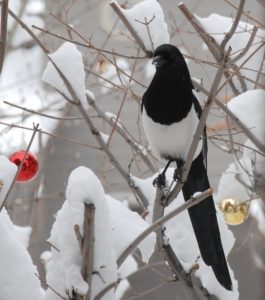Published by Kyle Kissock
Here at the Jackson Hole Wildlife Foundation we love communities coming together to engage in citizen science! This is one reason why our team is so excited to take part in the 2018 Christmas Bird Count (CBC), which is sponsored by the Jackson Hole Bird and Nature Club and will take place in Jackson on Saturday, December 15th.
It turns out, a citizen science bird count at Christmas is far from a fledgling affair. The idea was first proposed in 1900 by Frank Chapman, who worked at the American Natural History Museum in New York City. Chapman was also president of the newly formed Audubon Society and recognized declines in many avian populations due to over hunting. At the time, holiday traditions involving birds were generally lethal to the birds themselves, for example, the “Christmas Side Hunt,” which championed the individual who shot and returned home with the most feathers and furs. When Chapman and 27 volunteers set out to count, rather than kill, birds in the winter of 1900, their activity would have been quite the rarity.
 The CBC evolved from humble beginnings to include a total of 76,697 global participants in 2017.1 Last year, volunteers counted a whopping 56,000,000 individual birds. Participants here in Jackson Hole recorded a total of 59 species in our valley. This year’s count will mark the 119th anniversary of the CBC, which has blossomed into the largest, oldest, and most uninterrupted citizen science program in the world.
The CBC evolved from humble beginnings to include a total of 76,697 global participants in 2017.1 Last year, volunteers counted a whopping 56,000,000 individual birds. Participants here in Jackson Hole recorded a total of 59 species in our valley. This year’s count will mark the 119th anniversary of the CBC, which has blossomed into the largest, oldest, and most uninterrupted citizen science program in the world.
Data collected on the CBC has been invaluable to our understanding of avian population trends over time. What’s more, trends captured by the CBC are available to the public and professional scientists alike. In 2007, CBC data was used to develop the Common Birds in Decline Report. Along with the Breeding Bird Survey data, this report identified several species that have experienced precipitous declines over forty years of CBC data, including Eastern Meadowlarks, Evening Grosbeaks, and Northern Pintails, each of which experienced over 70% reduction since the mid-1960’s.2
CBC data has also been utilized in recent years by scientists seeking to understand how climate change and human influence are key players in altering ranges and migration patterns. An Audubon Climate Change Report in 2014 indicated climate change could affect ranges of 588 North American Birds.2 Some species, like Great-tailed Grackles, have increased their ranges (over 5000% according to one study) as human modified environments provide reliable food supplies and safer breeding grounds.3 Several other trends that the CBC has helped document are listed below:
- Corvids, a roosting species, have been drastically reduced by West Nile Virus – e.g. 99% mortality of American Crows who got the disease. However, there was a 70% survivorship of the closely related Fish Crow.
- The rare California Yellow-billed Magpie is also affected by West Nile.
- Common House Sparrows and European Starlings have both declined precipitously in the last few years both in this country and in their home lands in Europe. This data encourages additional research.
- Merlins, formerly a deep woods boreal falcon, are increasing. They have switched from dense forest to nesting in human altered environments even across the prairies.
If you are interested in accessing more trends, the Audubon Society is scheduled to release a trend viewer on their website in the following weeks. You can view historical CBC data by following this link to their website, including accessing data from the previous CBCs in Jackson.
And lastly if you’d like to join us and haven’t signed up for the Christmas Bird Count this Saturday, you can email the Bird and Nature Club at jhbirdclub@gmail.com sign up. Or just appear at Bubba’s, 100 Flat Creek Drive, in Jackson at 7:30 a.m. where we will gather for breakfast before dispersing in teams to our count areas. We’ll see you in the field!
- History of the Christmas Bird Count. Retrieved from audubon.org
- Butcher, G. S. and Niven, D.K. (2007). Combining Data from the Christmas Bird Count and the Breeding Bird Survey to Determining the Continental Status and Trends of North America Birds. National Audubon Society Publication. 25.
- Wehtje, W. (2003), The range expansion of the great‐tailed grackle (Quiscalus mexicanusGmelin) in North America since 1880. Journal of Biogeography, 30: 1593-1607
Thank to Frances Clark for sharing helpful notes from the 2018 Rocky Mountain Citizen Science Conference.
